|
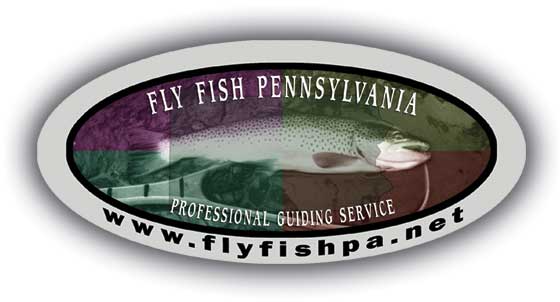
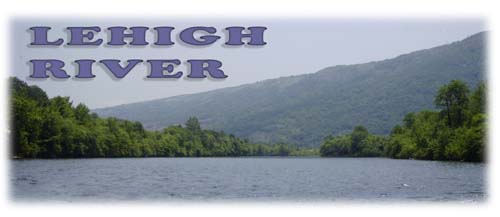 The
Lehigh River is another rugged Pennsylvania waterway we specialize in.
It originates from a series of glacial bogs on the PoconoPlateau at
an elevation of 2,100 feet and flows into the Delaware River at Easton,
PA - elevation of 200 feet. The upper portion of the Lehigh is considered
a coldwater, freestone stream and has that characteristic Pocono tannic
stain. Water is supplied to the Lehigh from three sources: snow melt,
rain and feeder streams. When worst case scenarios come together, flooding
has been a problem in the past along the Lehigh. Therefore, the idea
was born in the early 1960s to construct Francis E. Walter Reservoir
(FEW) above the town of White Haven. Built by the Army Corp of Engineers
(ACE) in 1962 as a flood control reservoir, FEW is constructed of earthen
rock, reaches depths of approximately 200 feet and is equipped with
a bottom-release. Like most rivers and reservoirs controlled by the
ACE, there are environmental management issues that could be improved
in our minds that would greatly enhance the fishery. However, what we
currently have is a fantastic fishery for our cold-water friends. But
it could be better!! The
Lehigh River is another rugged Pennsylvania waterway we specialize in.
It originates from a series of glacial bogs on the PoconoPlateau at
an elevation of 2,100 feet and flows into the Delaware River at Easton,
PA - elevation of 200 feet. The upper portion of the Lehigh is considered
a coldwater, freestone stream and has that characteristic Pocono tannic
stain. Water is supplied to the Lehigh from three sources: snow melt,
rain and feeder streams. When worst case scenarios come together, flooding
has been a problem in the past along the Lehigh. Therefore, the idea
was born in the early 1960s to construct Francis E. Walter Reservoir
(FEW) above the town of White Haven. Built by the Army Corp of Engineers
(ACE) in 1962 as a flood control reservoir, FEW is constructed of earthen
rock, reaches depths of approximately 200 feet and is equipped with
a bottom-release. Like most rivers and reservoirs controlled by the
ACE, there are environmental management issues that could be improved
in our minds that would greatly enhance the fishery. However, what we
currently have is a fantastic fishery for our cold-water friends. But
it could be better!!
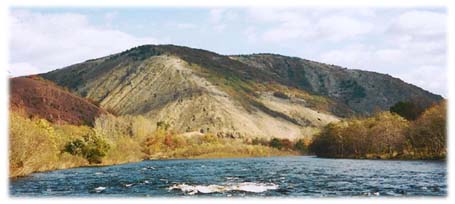 Downstream
of the dam, just south of White Haven you have the Gorge and its many
coldwater tributaries. This setup quickly swells the Lehigh into a large
and foreboding river by east coast standards. These coldwater tributaries
are also what maintain the rivers temperatures and allow the trout to
holdover extremely well during the warm weather months. From the bottom
of the Lehigh Gorge at Glen Onoko to the town of Lehighton, the Lehigh
still maintains its burley nature with long, heavy-white-water rapids,
large rocks, pocket water and deep pools. In the Lehighton to Bowmanstown
stretch the river decreases in gradient, but it still has some class
III rapids. In this stretch we tend to find a combo of deep pools and
steep banks. This setup can provide decent dry fly fishing during a
hatch. From Bowmanstown to Walnutport the river begins to decrease in
gradient. There are still some heavy whitewater rapids but not near
the length as upstream. What we do find are pools that are long and
deep, which provide the angler an opportunity to target large trout
slashing at emerging caddis or sipping mayflies from the surface film.
From Walnutport Downstream
of the dam, just south of White Haven you have the Gorge and its many
coldwater tributaries. This setup quickly swells the Lehigh into a large
and foreboding river by east coast standards. These coldwater tributaries
are also what maintain the rivers temperatures and allow the trout to
holdover extremely well during the warm weather months. From the bottom
of the Lehigh Gorge at Glen Onoko to the town of Lehighton, the Lehigh
still maintains its burley nature with long, heavy-white-water rapids,
large rocks, pocket water and deep pools. In the Lehighton to Bowmanstown
stretch the river decreases in gradient, but it still has some class
III rapids. In this stretch we tend to find a combo of deep pools and
steep banks. This setup can provide decent dry fly fishing during a
hatch. From Bowmanstown to Walnutport the river begins to decrease in
gradient. There are still some heavy whitewater rapids but not near
the length as upstream. What we do find are pools that are long and
deep, which provide the angler an opportunity to target large trout
slashing at emerging caddis or sipping mayflies from the surface film.
From Walnutport 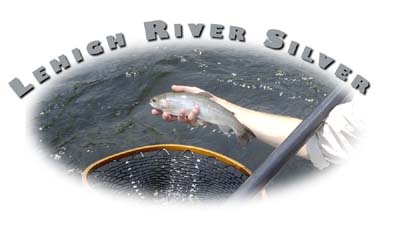 to
Northampton, the river maintains its character but begins to warm even
during the wettest of summers. Walnutport is what we consider the bottom
end of the prime trout water. All of the above is water we float in
a 16' ClackaCraft
driftboat. to
Northampton, the river maintains its character but begins to warm even
during the wettest of summers. Walnutport is what we consider the bottom
end of the prime trout water. All of the above is water we float in
a 16' ClackaCraft
driftboat.
The Lehigh is home to many different species of fish.
Brown, Rainbow and Brook trout are the most sought after species. Brown
and Rainbow trout grow big in the waters of the Lehigh. Each year the
river produces plenty of fish over 20" and fish in the 14-18"
range are the norm. Besides trout, the smallmouth bass population has
exploded in the past few years. The average smallmouth will range from
10" to 14" with a few going 16" and larger. Pickerel,
rock bass, and fallfish are also caught quite frequently.
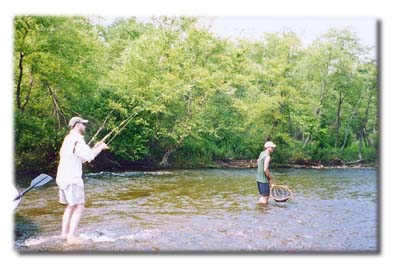 The
Lehigh is home to a smorgasbord of insect hatches. The Little Black
Stones begin to show themselves in early-April and can hatch in tremendous
numbers. If flows are decent and the water is clear, fish will key on
these insects as they struggle to take flight. The end of April will
see Little Black Caddis, Grannoms and Hendricksons, along with tan and
green-body Caddis. During sunny days, Caddis hatches can really bring
up the fish. May and June are "Prime Time" on the Lehigh.
May brings fantastic hatches of March Browns, Grey Fox, Sulphurs and
green-body Caddis. These hatches can bring up virtually every fish in
the river. June still has some Sulphurs along with Caddis, but the Blue
Wing Olives (size 14-18), Light Cahills and Isonychias will begin to
make an appearance. As summer begins, Caddis still hatch in good numbers
along with small Blue Wing Olives, Isonychias and the summer Stenonemas
(Sulphurs). Mornings can produce good hatches of Tricos in the Lehighton
to Bowmanstown stretch. As fall begins, Isonychias and evening hatches
of Sulphurs can be outstanding. Caddis and Blue Wing Olives will be
the flies the fish will key on as late fall approaches. Fishing with
streamers and Wooly Buggers can be quite productive during this time
of year as well. In fact, Wooly Buggers and streamers fished with a
sinking line will produce fish all year long. The
Lehigh is home to a smorgasbord of insect hatches. The Little Black
Stones begin to show themselves in early-April and can hatch in tremendous
numbers. If flows are decent and the water is clear, fish will key on
these insects as they struggle to take flight. The end of April will
see Little Black Caddis, Grannoms and Hendricksons, along with tan and
green-body Caddis. During sunny days, Caddis hatches can really bring
up the fish. May and June are "Prime Time" on the Lehigh.
May brings fantastic hatches of March Browns, Grey Fox, Sulphurs and
green-body Caddis. These hatches can bring up virtually every fish in
the river. June still has some Sulphurs along with Caddis, but the Blue
Wing Olives (size 14-18), Light Cahills and Isonychias will begin to
make an appearance. As summer begins, Caddis still hatch in good numbers
along with small Blue Wing Olives, Isonychias and the summer Stenonemas
(Sulphurs). Mornings can produce good hatches of Tricos in the Lehighton
to Bowmanstown stretch. As fall begins, Isonychias and evening hatches
of Sulphurs can be outstanding. Caddis and Blue Wing Olives will be
the flies the fish will key on as late fall approaches. Fishing with
streamers and Wooly Buggers can be quite productive during this time
of year as well. In fact, Wooly Buggers and streamers fished with a
sinking line will produce fish all year long.
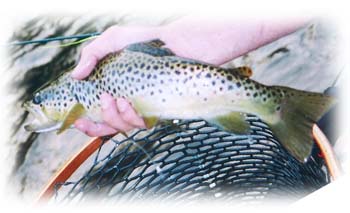 Along
the course of the Lehigh there are a few local conservation groups that
stock the River from the bottom of the Lehigh Gorge to Northampton.
One of the largest groups is the Lehigh
River Stocking Association (LRSA). The LRSA stocks thousands of
trout in this stretch each year, ranging in size from 11" to 28."
Besides fish stockings, the LRSA conducts numerous water quality studies,
river cleanups, acid mine drainage reduction projects as well as educating
the local residents on environmental conservation. We highly suggest
supporting the LRSA! Please help in preserving our cold-water resources. Along
the course of the Lehigh there are a few local conservation groups that
stock the River from the bottom of the Lehigh Gorge to Northampton.
One of the largest groups is the Lehigh
River Stocking Association (LRSA). The LRSA stocks thousands of
trout in this stretch each year, ranging in size from 11" to 28."
Besides fish stockings, the LRSA conducts numerous water quality studies,
river cleanups, acid mine drainage reduction projects as well as educating
the local residents on environmental conservation. We highly suggest
supporting the LRSA! Please help in preserving our cold-water resources.
Most agree that the Lehigh is truly a magnificent river
with characteristics of a big western river. The scenery and abundant
wildlife along the river alone are worth the trip. At times it is hard
to believe you are only an hour from the suburbs of Philadelphia. Isn't
it time you checked out the best kept secret in Northeastern US fly
fishing? If you are interested in experiencing the "Madison River"
of the East, feel free to give us a call or shoot us an email.
|

 The
Lehigh River is another rugged Pennsylvania waterway we specialize in.
It originates from a series of glacial bogs on the PoconoPlateau at
an elevation of 2,100 feet and flows into the Delaware River at Easton,
PA - elevation of 200 feet. The upper portion of the Lehigh is considered
a coldwater, freestone stream and has that characteristic Pocono tannic
stain. Water is supplied to the Lehigh from three sources: snow melt,
rain and feeder streams. When worst case scenarios come together, flooding
has been a problem in the past along the Lehigh. Therefore, the idea
was born in the early 1960s to construct Francis E. Walter Reservoir
(FEW) above the town of White Haven. Built by the Army Corp of Engineers
(ACE) in 1962 as a flood control reservoir, FEW is constructed of earthen
rock, reaches depths of approximately 200 feet and is equipped with
a bottom-release. Like most rivers and reservoirs controlled by the
ACE, there are environmental management issues that could be improved
in our minds that would greatly enhance the fishery. However, what we
currently have is a fantastic fishery for our cold-water friends. But
it could be better!!
The
Lehigh River is another rugged Pennsylvania waterway we specialize in.
It originates from a series of glacial bogs on the PoconoPlateau at
an elevation of 2,100 feet and flows into the Delaware River at Easton,
PA - elevation of 200 feet. The upper portion of the Lehigh is considered
a coldwater, freestone stream and has that characteristic Pocono tannic
stain. Water is supplied to the Lehigh from three sources: snow melt,
rain and feeder streams. When worst case scenarios come together, flooding
has been a problem in the past along the Lehigh. Therefore, the idea
was born in the early 1960s to construct Francis E. Walter Reservoir
(FEW) above the town of White Haven. Built by the Army Corp of Engineers
(ACE) in 1962 as a flood control reservoir, FEW is constructed of earthen
rock, reaches depths of approximately 200 feet and is equipped with
a bottom-release. Like most rivers and reservoirs controlled by the
ACE, there are environmental management issues that could be improved
in our minds that would greatly enhance the fishery. However, what we
currently have is a fantastic fishery for our cold-water friends. But
it could be better!! Downstream
of the dam, just south of White Haven you have the Gorge and its many
coldwater tributaries. This setup quickly swells the Lehigh into a large
and foreboding river by east coast standards. These coldwater tributaries
are also what maintain the rivers temperatures and allow the trout to
holdover extremely well during the warm weather months. From the bottom
of the Lehigh Gorge at Glen Onoko to the town of Lehighton, the Lehigh
still maintains its burley nature with long, heavy-white-water rapids,
large rocks, pocket water and deep pools. In the Lehighton to Bowmanstown
stretch the river decreases in gradient, but it still has some class
III rapids. In this stretch we tend to find a combo of deep pools and
steep banks. This setup can provide decent dry fly fishing during a
hatch. From Bowmanstown to Walnutport the river begins to decrease in
gradient. There are still some heavy whitewater rapids but not near
the length as upstream. What we do find are pools that are long and
deep, which provide the angler an opportunity to target large trout
slashing at emerging caddis or sipping mayflies from the surface film.
From Walnutport
Downstream
of the dam, just south of White Haven you have the Gorge and its many
coldwater tributaries. This setup quickly swells the Lehigh into a large
and foreboding river by east coast standards. These coldwater tributaries
are also what maintain the rivers temperatures and allow the trout to
holdover extremely well during the warm weather months. From the bottom
of the Lehigh Gorge at Glen Onoko to the town of Lehighton, the Lehigh
still maintains its burley nature with long, heavy-white-water rapids,
large rocks, pocket water and deep pools. In the Lehighton to Bowmanstown
stretch the river decreases in gradient, but it still has some class
III rapids. In this stretch we tend to find a combo of deep pools and
steep banks. This setup can provide decent dry fly fishing during a
hatch. From Bowmanstown to Walnutport the river begins to decrease in
gradient. There are still some heavy whitewater rapids but not near
the length as upstream. What we do find are pools that are long and
deep, which provide the angler an opportunity to target large trout
slashing at emerging caddis or sipping mayflies from the surface film.
From Walnutport  to
Northampton, the river maintains its character but begins to warm even
during the wettest of summers. Walnutport is what we consider the bottom
end of the prime trout water. All of the above is water we float in
a 16'
to
Northampton, the river maintains its character but begins to warm even
during the wettest of summers. Walnutport is what we consider the bottom
end of the prime trout water. All of the above is water we float in
a 16'  The
Lehigh is home to a smorgasbord of insect hatches. The Little Black
Stones begin to show themselves in early-April and can hatch in tremendous
numbers. If flows are decent and the water is clear, fish will key on
these insects as they struggle to take flight. The end of April will
see Little Black Caddis, Grannoms and Hendricksons, along with tan and
green-body Caddis. During sunny days, Caddis hatches can really bring
up the fish. May and June are "Prime Time" on the Lehigh.
May brings fantastic hatches of March Browns, Grey Fox, Sulphurs and
green-body Caddis. These hatches can bring up virtually every fish in
the river. June still has some Sulphurs along with Caddis, but the Blue
Wing Olives (size 14-18), Light Cahills and Isonychias will begin to
make an appearance. As summer begins, Caddis still hatch in good numbers
along with small Blue Wing Olives, Isonychias and the summer Stenonemas
(Sulphurs). Mornings can produce good hatches of Tricos in the Lehighton
to Bowmanstown stretch. As fall begins, Isonychias and evening hatches
of Sulphurs can be outstanding. Caddis and Blue Wing Olives will be
the flies the fish will key on as late fall approaches. Fishing with
streamers and Wooly Buggers can be quite productive during this time
of year as well. In fact, Wooly Buggers and streamers fished with a
sinking line will produce fish all year long.
The
Lehigh is home to a smorgasbord of insect hatches. The Little Black
Stones begin to show themselves in early-April and can hatch in tremendous
numbers. If flows are decent and the water is clear, fish will key on
these insects as they struggle to take flight. The end of April will
see Little Black Caddis, Grannoms and Hendricksons, along with tan and
green-body Caddis. During sunny days, Caddis hatches can really bring
up the fish. May and June are "Prime Time" on the Lehigh.
May brings fantastic hatches of March Browns, Grey Fox, Sulphurs and
green-body Caddis. These hatches can bring up virtually every fish in
the river. June still has some Sulphurs along with Caddis, but the Blue
Wing Olives (size 14-18), Light Cahills and Isonychias will begin to
make an appearance. As summer begins, Caddis still hatch in good numbers
along with small Blue Wing Olives, Isonychias and the summer Stenonemas
(Sulphurs). Mornings can produce good hatches of Tricos in the Lehighton
to Bowmanstown stretch. As fall begins, Isonychias and evening hatches
of Sulphurs can be outstanding. Caddis and Blue Wing Olives will be
the flies the fish will key on as late fall approaches. Fishing with
streamers and Wooly Buggers can be quite productive during this time
of year as well. In fact, Wooly Buggers and streamers fished with a
sinking line will produce fish all year long. Along
the course of the Lehigh there are a few local conservation groups that
stock the River from the bottom of the Lehigh Gorge to Northampton.
One of the largest groups is the
Along
the course of the Lehigh there are a few local conservation groups that
stock the River from the bottom of the Lehigh Gorge to Northampton.
One of the largest groups is the